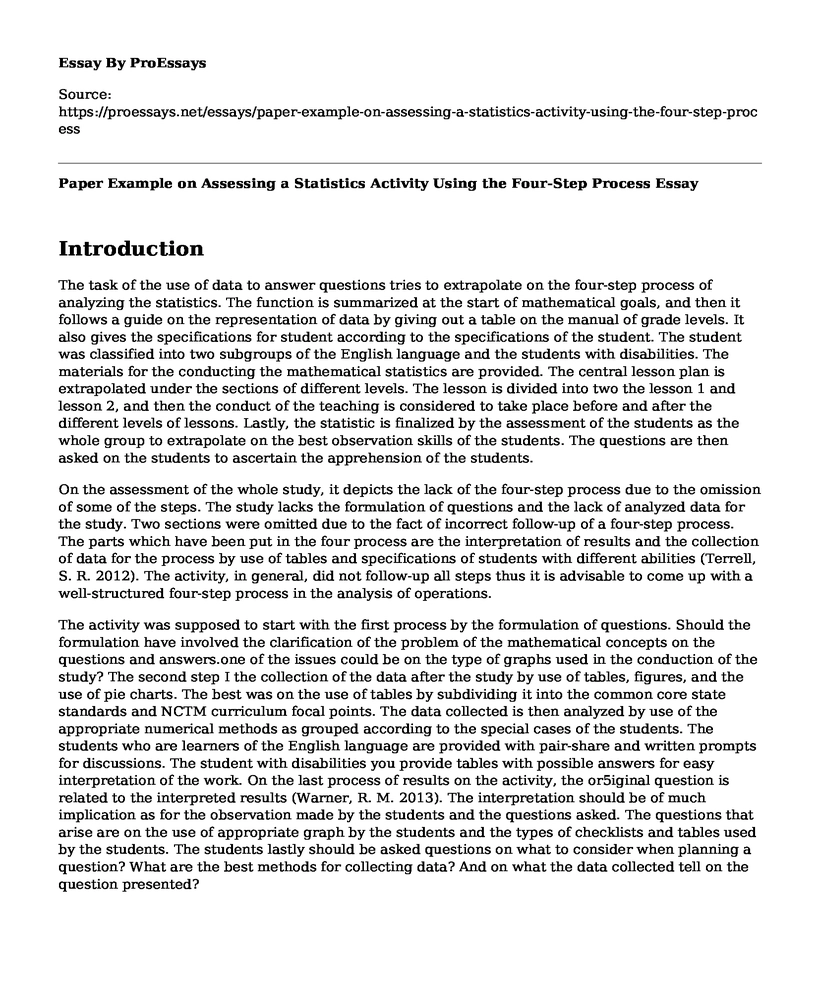Introduction
The task of the use of data to answer questions tries to extrapolate on the four-step process of analyzing the statistics. The function is summarized at the start of mathematical goals, and then it follows a guide on the representation of data by giving out a table on the manual of grade levels. It also gives the specifications for student according to the specifications of the student. The student was classified into two subgroups of the English language and the students with disabilities. The materials for the conducting the mathematical statistics are provided. The central lesson plan is extrapolated under the sections of different levels. The lesson is divided into two the lesson 1 and lesson 2, and then the conduct of the teaching is considered to take place before and after the different levels of lessons. Lastly, the statistic is finalized by the assessment of the students as the whole group to extrapolate on the best observation skills of the students. The questions are then asked on the students to ascertain the apprehension of the students.
On the assessment of the whole study, it depicts the lack of the four-step process due to the omission of some of the steps. The study lacks the formulation of questions and the lack of analyzed data for the study. Two sections were omitted due to the fact of incorrect follow-up of a four-step process. The parts which have been put in the four process are the interpretation of results and the collection of data for the process by use of tables and specifications of students with different abilities (Terrell, S. R. 2012). The activity, in general, did not follow-up all steps thus it is advisable to come up with a well-structured four-step process in the analysis of operations.
The activity was supposed to start with the first process by the formulation of questions. Should the formulation have involved the clarification of the problem of the mathematical concepts on the questions and answers.one of the issues could be on the type of graphs used in the conduction of the study? The second step I the collection of the data after the study by use of tables, figures, and the use of pie charts. The best was on the use of tables by subdividing it into the common core state standards and NCTM curriculum focal points. The data collected is then analyzed by use of the appropriate numerical methods as grouped according to the special cases of the students. The students who are learners of the English language are provided with pair-share and written prompts for discussions. The student with disabilities you provide tables with possible answers for easy interpretation of the work. On the last process of results on the activity, the or5iginal question is related to the interpreted results (Warner, R. M. 2013). The interpretation should be of much implication as for the observation made by the students and the questions asked. The questions that arise are on the use of appropriate graph by the students and the types of checklists and tables used by the students. The students lastly should be asked questions on what to consider when planning a question? What are the best methods for collecting data? And on what the data collected tell on the question presented?
Conclusion
Conclusively the four-step process in analyzing of activities is very vital in the essence of giving condensed and accurate results thus decision-making process is fastened in the statistics.
References
Bourne, V. (2017). Starting out in methods and statistics for psychology: A hands-on guide to doing research.
Terrell, S. R. (2012). Statistics translated: A step-by-step guide to analyzing and interpreting data. New York: Guilford Press.
Warner, R. M. (2013). Applied statistics: from bivariate through multivariate techniques. SAGE Publications.
Cite this page
Paper Example on Assessing a Statistics Activity Using the Four-Step Process. (2022, Jul 01). Retrieved from https://proessays.net/essays/paper-example-on-assessing-a-statistics-activity-using-the-four-step-process
If you are the original author of this essay and no longer wish to have it published on the ProEssays website, please click below to request its removal:
- Nursing Research on Distinguishing Between Univariate and Bivariate Statistics Paper Example
- Personal Statement: Georgetown MS in Mathematics and Statistics
- Essay Sample on White Collar Crime
- Essay Sample on Data Visualization: A Vital Tool for Statistics Experts
- Essay Sample on My Applied Managerial Statistics Experience: From Fear to Surprise
- Explore Sentinel City: Population and Income Analysis of Four Neighborhoods - Free Paper
- Average: From Colloquial Terms to Lt. Daniels' Findings







